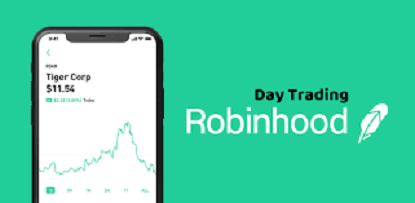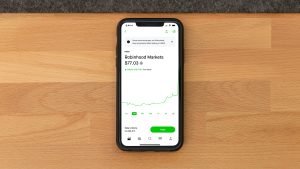Robinhood has grown to be among the top-rated forex brokers in 2022. This is because of its easy-to-use interface and no commission fee. In addition to that, there are tons of other features that make the platform outstanding.
The search for how to day trade on Robinhood has increased in recent months, and this is because of its commission-free and easy-to-use interface that will help beginners go a long way.
Also, as day trading is a trading strategy with less risk when compared to others, most beginners have adopted it. They combine this strategy with Robinhood’s amazing features in order to have a better experience and spend less on transaction charges.
If you are someone who has looked into the different trading strategies and has chosen day trading as the best for yourself, then this post is for you because in this post, I am going to walk you through a step-by-step guide on how to day trade on Robinhood.
In addition to their web-based interface, Robinhood has a user-friendly mobile app that can be downloaded freely for Android and iOS phones. This app will allow you to access your market from anywhere and at any point in time.
Table of Contents
What is day trading?
Day trading is a trading strategy in the stock market whereby a trader buys or sells stocks during the day.
In contrast to swing traders, who profit largely on the swings that appear in a trend, day traders make a small profit per trade, but the good thing about it is that they have more opportunities in the market to place trades, and when they win these trades, their profit will be large when summed up.
7 Steps On How To Day Trade On Robinhood.
In this section of the post, we will walk you through 7 major steps that will help you learn how to day trade on Robinhood.
In order to hasten your learning process and reduce the losses that you could incur while learning, it is very important that you pay closer attention and follow these guidelines.
Below are the 7 major steps that will help you learn how to day trade on Robinhood.
Step 1: Open a trading account.
Before starting to day trade on Robinhood, you must create an account with them.
If you don’t have a Robinhood trading account before, it is important that you follow this link to create an account with them so that you will be able to follow along with all that we will be covering today.
Depending on the type of trading account you want to open, Robinhood has a different minimum deposit for each of them.
It is important to note that Robinhood restricts some certain countries’ access to its offerings, and it is very important that you review the countries that have access to them by clicking here.
Also, I would like to remind you that Robinhood does not offer a free demo account to new users. The demo account available in the interface is for traders who want to practice some trades without risking any money, but Robinhood does not provide this type of practice environment for its new users.
Step 2: Choose the stock you want to day trade.
Once you have successfully created an account with them, the next thing to do is choose a stock to trade. There are a lot of stocks available on Robinhood, and it is best if you select a few (or most likely one) and become acquainted with them. Alibaba (NYSE: BABA), Amazon (NASDAQ: AMZN), and Chevron (NYSE: CVX) are all available stocks on Robinhood.
Step 3: Do Market Research
Once you have successfully created an account with Robinhood and have determined some stocks you will be interested in, you are now ready to start off your trading journey.
Although the stock market is profitable when traded correctly, it does more harm than good when it is done the wrong way. Before trading any stock, it is very important to research the market and have a better understanding of the stock you want to trade.
At this point, you will need to understand the chart pattern, trend, and technical analysis. This will help you identify and leverage some opportunities that pop up in the market. Also, having a better understanding of this will help shape your market psychology and put it on the right track because anything you do will be referred to some certain point.
Step 4: Identify Signals (Opportunity).
A trading signal or opportunity is a trigger to buy or sell the market depending on the direction the technical analysis dictates.
If you understand technical analysis very well, you need not be told that technical analysis sums up to identifying a trend, area of value, and signal in the chart pattern.
Once you have identified the trend from your market research, the next thing is to identify signals in the area of values. Depending on the region where you identified these signals, You can go short or go long in the market.
Step 5: Buy at Support and sell at Resistance level.
The market’s support level is the level where the falling price reaches and starts to rise, whereas the market’s resistance level is the level where the rising price appears to stop and start to fall, and this must have happened two or more times.
Usually, signals seen at the support level (higher highs) suggest going long on the market while Signals seen across the resistance level suggest going short in the market.
Step 6: Place Stop Loss and Take profit order.
In trading, there is what is called risk management. Risk management is the ability of a trader to minimize his or her losses and maximize profits. It sounds so simple, but things get innocent the moment you understand that it is a contradictory concept.
In trading, before you place your orders, it is important that you place your stop loss and take profit orders. A stop loss order is an order to close the market when the price of the stock gets to a certain amount against your position.
On the other hand, a take profit profit order is an order to close the market when the price of the stock gets to a certain amount in favor of your position.
While trading, it is very important that you observe these two concepts and implement them in order to minimize the losses that you could incur in the market.
Step 7: Close your trades.
Once you’ve identified an entry opportunity and placed your order, it’s essential to keep a close eye on it so you can exit when the market moves against you. When trading, you should always try to stay away from any distractions that could cause your trades to fail.
If your stop loss or take profit order does not close your trade, close it according to your trading strategy. This is only possible if you keep a close eye on the market.
The Pros and Crons of Robinhood
Robinhood has some features that make it stand out from other trading platforms.
Below are the pros and cons of the Robinhood trading platform.
Pros:
- User-friendly platforms
- No fee for Trade
- A large number of stocks to choose from
- Highly Regulated
- Bonus on sign up
Crons:
- No Desktop app
-
Geographic restriction
Robinhood Day Trading Rules and Restrictions
Robinhood has some rules that dictates the amount of trades investors can execute over a particular period of time.
The first and the most popular one is the pattern day trading rules, This rule states that traders can’t place more than 3 trades within a five day period unless his account size is more than $2500.
The penalty for a breaking this is a restriction of account for placing of more trading for a 90day period
However, for day traders using Robinhood, there are some exceptions.
You can read more about these rules by clicking here.
Is The Robinhood App Good for Day Trading?
Yes, because it allows you to buy and sell stocks for a profit within a 24-hour period, the Robinhood app is perfectly good for day trading.
Also, as day traders are meant to place a number of trades per day, the Robinhood app is a good leverage for them as it is a commission-free platform.
What is the best account type in Robinhood?
Depending on your trading strategy and the main purpose of your account, Robinhood has three major accounts you can choose from. Each of them has its own advantages and disadvantages.
The three types of accounts available on Robinhood, with their advantages and disadvantages, are discussed below.
1. Robinhood Instant
A Robinhood instant account is the account option that allows you to make an instant deposit. Instant deposit means that there won’t be any wasting of time on processing of funds while depositing.
Instant deposit processing works for deposits that are within $1000. If it is greater than this, the order will take five or more working days to execute.
2. Robinhood Gold
A Robinhood Gold account is an upgraded account that needs a monthly maintenance fee of $5. When using this account, you will have access to more extensive deposits.
It also provides users with stock market research from Morning Star, a well-known investment and research firm, as well as Level II data.
3. Robinhood Cash
Robinhood Cash is a simple, no-frills account. Instant deposits and settlements will not be available to users. The cash account, on the other hand, allows you to trade commission-free during both extended and regular market hours. You can switch between Robinhood Instant and Robinhood Gold accounts at any time.

